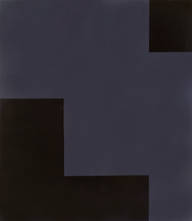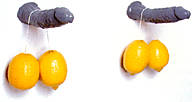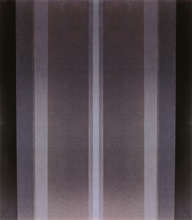

By Øystein Loge
views or falls
A balcony is an architectonic ornament, composed along with other elements of a facade, a jewel that contributes to the beauty of a building. It consists of a plane that shoots forth from the vertical wall, high up, and a door that gives access from the interior of the building. The balcony has a rail or balustrade, often decorative, that protects those who step out to enjoy the view from falling down. Stepping out on a balcony, everyone has the same thought: This is high up.
The balcony represents, with its architectonic beauty, the intelligible world, a world that receives its form from the beauty that man creates. It is a world according to man’s intellect. A world to feel at home in.
The view, however, the depths below, the sounds we hear in the distance and the hills that dissolve into blue and light grey in the distance, and the accompanying fear of heights, these represent the opposite. But if there was no abyss there would be no balcony. It is not by chance that the railing is so beautifully constructed. We cling to it, with our hands, high above the abyss.
And we cling to it, to its harmonious shape and proportions, to protect our reason from the call of the abyss.
The balcony is of course what Nietzsche called the Apollonian and the abyss is the Dionysian.
penetrates or is devoured
There are no balconies in Gudjón Bjarnason’s pictures, not really, they are not figuratively represented. His balconies are systems of circular or rectangular shapes. They are always there, between the pictures where the abyss opens, and in the pictures of the abyss themselves.
Bjarnason utilises our ability to read non-representational pictures, their mood, what they represent in visual terms, in their construction.
But there are also representational elements and the reader is already waiting for my interpretation of them: The dildos, the many erect male sexual organs, the penises.
These series can be seen in two different ways:
Either they are a regiment on parade, ready for battle, strutting with aggressive self-confidence.
Or, as I see them, in their context, through a metaphor: In Norway we use a special float to fish for trout, a sort of miniature boat that supports the line taut in the water and that we steer from the shore or standing in a boat. Short lines are affixed to the fishing line and on each there is a hook. On every hook there is live bait, waiting for the trout’s strong, toothed jaw.
Bjarnason’s row of penises can be seen as just such an array of bait, waiting to be devoured by the fish when it shoots up from the deep, and incapable of intervention.
All recent research into sexual symbolism recognises the ambivalent aspects of the physical union of the sexes: Perhaps the male organ forces itself into the female, in a deliberate act, penetrating.
Or perhaps it is driven by forces that we will never tire of investigating to let itself be swallowed, devoured, as by a hungry mouth. Like the bait.
We can at any rate confirm that this ambivalence is found in these works.
to investigate, or to release the storm
The sculptures speak of the same things. We see the twisted and deformed remains of metal constructions that have been exploded with dynamite. But the chaotic forces have not released altogether, not without a degree of control.
Chaos has been handled as in a controlled experiment: Measured amounts of explosive have been used for each construction using a scale of increased explosive force. The artist holds on to the railing of the balcony while he surveys the boiling sea beneath. He sets the intellect against forces that in reality cannot be controlled - the unpredictable effects of the explosive forces. He can set off the reaction, but he cannot know what shape the objects will take on as a result of the force that is released. He wants to be close to this process, this metamorphosis. And he knows that the control he projects into the process is a symbolic barricade against the symbolism of the forces of chaos.
Emil Nolde did the same, long ago, when he laid his watercolours on the balcony and let the snow fall on them, to let nature in as a co-creator, a silent assistant.
The steel beams in these experiment are - when the artist brings them in to be exploded - in the ontological state of thinghood. What he does, as a significant symbolic act, is to let something intervene in that state. He denies the thing its thinghood; he de-things the thing. A thing is a thing because it belongs to a system of actions, of intentions, formed to its purpose, perhaps with some consideration for aesthetic values. Things are words in a collective language. Heidegger and the Surrealists were concerned with the thing as the building block of our intelligible world. When things were taken out of their syntactic context, they could show the limits of this world, its fragility. And most of all that it is not a given world, not natural.
It is nature that Bjarnason has released here to deny the things their thinghood.
In these works Bjarnason seeks to situate himself where the Apollonian meets the Dionysian. What can be more natural for an Icelandic artist? Camille Paglia follows Nietzsche when she directs her attention to what she calls ‘chthonic’ nature. With this Greek term she points out that nature is not a ‘thing’, that it does not consist of units that can be clearly individuated ontologically or visually defined, as art and science would have us believe, but that it is an eternal, churning process. ‘One cannot step twice into the same river.’ Nature knows no numbers, nor any outlines or delineation. There is no inner or outer in nature. Nature is birth and death.
This insight was shared by the pre-Olympic myths and the pre-Socratic philosophers. The Titanic myths recognise man’s angst and suffering behind the natural processes. In The Birth of Tragedy Nietzsche writes of how the Dionysian insight marks the beginning of the Olympian phase: ‘We must imagine this development involving the transformation of the original, Titanic pantheon of terror into the Olympian seat of joy. This took place little by little, through the Apollonian quest for beauty, like roses growing from a thorny bush.’ Nietzsche sees the Apollonian impulse as protection against Dionysian suffering. But the premise of Nietzsche’s analysis of tragedy is that the opposition between the Apollonian and the Dionysian lived on in classical culture. As a counterbalance to the Homeric/Olympian Apollonian art and cult, the Dionysian cult spread from the seventh century bc on, as a mystic cult characterised by ecstasy and intoxication.
It was Apollo, Pythagoras and classical art that came to characterise Western culture, even though the alternative has always existed and has inspired some thinkers and artists.
Gudjón Bjarnason comes from Iceland, a country where nature has never ceased recreating itself, again and again. The Icelanders are very conscious of their island’s volcanic nature: The landscape changes, new islands are created or disappear into the sea.
At a time when art again embraces the sublime, atomic physicists study chaos and irreversibility as laws, and philosophers research the Apollonian impulse as the basis of a narrow understanding of reality, what could be more apt than for an Icelandic artist to immerse himself in the unique natural forms of his country and thus ask the same questions.
The balcony provides the perspective for our culture. The view of the abyss is the primary task for our time.
In Bjarnason’s works this dual existential situation, the balcony and the abyss, are expressed as an opposition between two categories of visual elements. At the bottom lie unformed, natural earth-and-lava coloured masses, often almost glowing in colour, sometimes dull, matt, almost dead. Above this are incised clearly delineated geometric forms that are untouched by the natural forms, but maintain rather a studious distance. This opposition is similar to C.D. Friedrich’s landscapes that are viewed by intellectual city-dwellers who have gone in their city clothes into nature to view it, to contemplate it. When these people in Friedrich’s paintings from the early nineteenth century view nature they are conscious of their own distance from it and they try to counteract it through an understanding of the sublime. I see Bjarnason’s geometric shapes as symbols of this distance. Thus it is not the geometric forms themselves that provide the parallel to Friedrich’s paintings, but the artist himself.
As I write this I have before me a painting from the collection of the Drammen Art Museum: From Bastei by the romantic painter J.C. Dahl, a landscape from just south of Dresden painted in 1819. It is strongly influenced by Friedrich, painted when Dahl first worked with Friedrich in the academy at Dresden. The painting shows a group of three city-dwellers, a balcony and an abyss. The abyss is a mountainous landscape lost in the distance with formations that more resemble the mesas of Arizona than a normal German landscape. The balcony is a small outcrop of rock where a sturdy fence of vertical and horizontal planks provides a protective railing against the deathly abyss. The only man-made thing in the picture, it represents the intellect’s barricade against the Dionysian dangers of the landscape. The Apollonian defence, Nietzsche would have said.
These are timeless subjects in Western culture. The outer nature represents our inner nature and the two dimensions are in dialogue.
This is precisely what they are in Bjarnason’s works. The lava fields are his Icelandic source for being drawn into the Dionysian mystery. But he is conscious of the distance that now separates man from this dimension. Therefore, in an art that is both general and international, the geometric with its minimalist structure stands in eternal opposition to the chthonic witches’ cauldron of the abyss.
Øystein Loge, Ph.D., is chief curator and leader of the art department of the Drammen Museum of art and cultural history, Norway. His main publications are: Gartneren under regnbuen: Nikolai Astrup, Oslo, 1986; Deformasjon, Bergen - Oslo, 1991; Blomsten Berget og St.Hansnatten, Nikolai Astrup, Oslo, 1994. This text was printed in the catalogue for Gudjón Bjarnason’s exhibition in the Nordic House in Reykjavík in the summber of 1997, entitled Large Works.
Exploded steel, oil and varnish, mirror, 66 x 150 x 150 cm

Oil on canvas, 233 x 207 cm

Painted cast steel and lemons,
17 x 600 x 20 cm

Exploded steel, oil and varnish, 44 x 350 x 350 cm

Oil on canvas, 233 x 202.5 cm

Oil on canvas, 233 x 202.5 cm
|
|
|
|
|
|
|
|